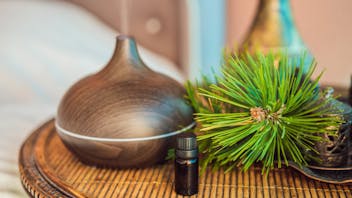Product Overview
Our organic Lemon Verbena essential oil has a bright, somewhat fruity and herbaceous, sweet-tart, lemony aroma with fresh green, crisp citrus-like and light floral nuances that will give extraordinary lift to your perfume formulations. It is an excellent variation on the use of citrus oils in creating lively, sparkling top note accords.
This vibrant oil may become a favorite ally to brighten the spirit – perfect to diffuse or include in hand and foot lotions, body mists and massage oils. However, please note that this product is actually prohibited by the IFRA and EU, according to Tisserand, “presumably more due to its sensitization potential than its modest phototoxicity.”[1] He further states that “since only 12% concentrations were used in testing, the IFRA/EU guideline is unjustified,” and therefore recommends a maximum dermal use level of 0.9%.[2]
Aloysia citriodora (the binomial Lippia citriodora is now considered a synonym), a deciduous shrub 5-16 feet high, is native to Chile and Argentina, but is also grown in Kenya and China and around the Mediterranean region. The aldehydic citrals, neral and geranial – constituents crucial to odor quality and aromatic benefits – increase during flowering. Thus, Lemon Verbena oils distilled in spring result in higher yields with greater percentages of desirable citrals than those distilled in autumn after enduring the typical botanical stresses of summer.[3] In order to maximize quality and quantity of the precious, low-yielding oil, experienced distillers will utilize the post-harvest practice of slow and deliberate shade-drying of the leaves rather than more rapid sun or oven drying methods.
Because the yield is very low, and cultivation of Lippia involves considerable problems with regard to climate and other factors, genuine Lemon Verbena essential oil should be quite costly.[4] Inexpensive ‘Lemon Verbena’ oils are likely to be adulterated with low cost sources of citrals, synthetically derived citrals, or from Litsea cubeba or Lemongrass. True Lemon Verbena is not to be confused with the oil of Spanish Verbena (Thymus hyemalis) or the herb Vervain (Verbena officinalis).[5]
1 Tisserand, Robert and Rodney Young. Essential Oil Safety, 2nd ed., 2014, p. 465.
2 Ibid, pp. 464-5.
3 Guenther, Ernest. The Essential Oils, Vol. I, 1948, pp. 70-1.
4 Arctander, Steffen. Perfume and Flavor Materials of Natural Origin, 1960, p. 648.
5 Lawless, Julia. The Encyclopedia of Essential Oils, 2013, p. 198.



